Explore Kunming - China Travel, Asia
Nestled in the heart of Yunnan Province, Kunming is a city where the past meets the present, and nature’s splendor is on full display. Kunming, known as the "Spring City" for its pleasant year-round weather, is a bustling city full of natural beauty, contemporary conveniences, and cultural diversity. From its ancient streets to its bustling markets, Kunming invites travelers to explore its unique charm, offering a perfect blend of history, culture, and adventure. Whether you’re drawn by its stunning landscapes or intrigued by its diverse ethnic heritage, Kunming has something for every traveler.
Population: Approximately 8.4 million in 2020.
Economy: As the main commercial hub of Southwest China, Kunming’s economy takes advantage of 3 main aspects: natural resources, gigantic consumer market and mild climate.
Landmarks: Famous for the Stone Forest in Shilin National Park, Green Lake Park, and Western Hills.
China
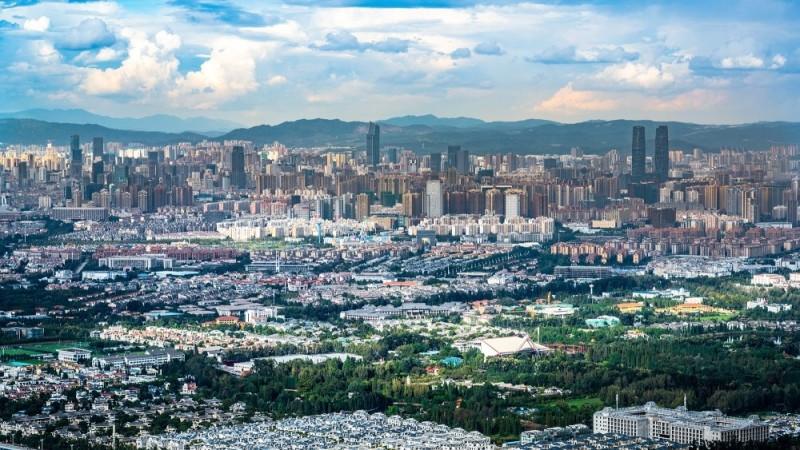
Overview of Kunming
History & Culture Influence
The history of Kunming is one of prosperous commercial routes, historic routes, and a plethora of cultural influences. As the capital of Yunnan Province, Kunming has been a significant cultural and political hub for centuries. It was once a vital stop along the Southern Silk Road, connecting China to Southeast Asia and beyond. This rich history is still palpable today, from the ancient temples that dot the city to the traditional festivals celebrated by its diverse population.
The city is home to many ethnic minorities, including the Yi, Bai, and Hui, each contributing to Kunming’s vibrant cultural tapestry. Their influence can be seen in everything from the city’s architecture to its culinary traditions. Temples and pagodas stand as testaments to the city’s Buddhist heritage, while colorful festivals bring the streets to life, celebrating the customs passed down through generations.
Interaction with The Locals
Kunming, the capital of Yunnan Province, is home to over 8.4 million people. The city is known for its diverse population, with over 25 ethnic minority groups, including the Yi, Bai, Hui, and Dai people, adding to its rich cultural tapestry. Kunming’s citizens are known for their friendliness and hospitality, making it easy for visitors to feel welcome. The city’s vibrant mix of cultures is reflected in its festivals, cuisine, and daily life, offering travelers a unique and immersive experience.
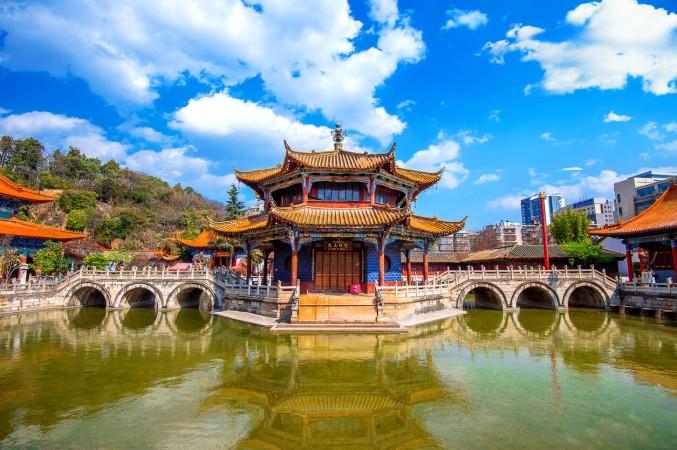
Yuantong Temple - © iStock
Top Attractions in Kunming
Kunming is a city of contrasts, where natural wonders sit alongside historical landmarks. These are some must-visit attractions in Kunming that showcase the best of what the city has to offer:
Stone Forest (Shilin National Park)
Just a short drive from the city, this UNESCO World Heritage Site is a geological wonder. The Stone Forest’s towering limestone formations create a surreal landscape that has fascinated visitors for centuries. It’s a place where nature’s artistry is on full display, making it a must-see for any traveler.
Green Lake Park (Cuihu Park)
Located in the heart of Kunming, Green Lake Park is a serene escape from the city’s hustle and bustle. Known for its stunning lotus blossoms in summer and migratory seagulls in winter, the park is a favorite spot for both locals and tourists. Whether you’re taking a leisurely stroll or enjoying a boat ride on the lake, this park offers a peaceful retreat.
Western Hills (Xishan)
Hiking enthusiasts love the Western Hills because they provide expansive views of Dianchi Lake. The area is home to several temples and pavilions, including the Dragon Gate Grottoes, where visitors can enjoy breathtaking vistas and explore ancient carvings. The combination of natural beauty and cultural significance makes this a must-see.
Yunnan Nationalities Village
For those interested in the cultural diversity of Yunnan Province, this village is a perfect introduction. The park features replicas of traditional homes and showcases the customs, costumes, and traditions of Yunnan’s many ethnic groups. It’s a vibrant and educational experience that brings the province’s rich heritage to life.
Dongchuan Red Land
Located about 150 kilometers northeast of Kunming, Dongchuan Red Land is a hidden gem known for its striking red soil, which creates a patchwork of vibrant colors across the landscape. The best time to visit is in the late afternoon when the setting sun illuminates the fields, creating a breathtaking spectacle. This rustic setting makes for an amazing background for photos and wildlife enthusiasts alike to create priceless memories.
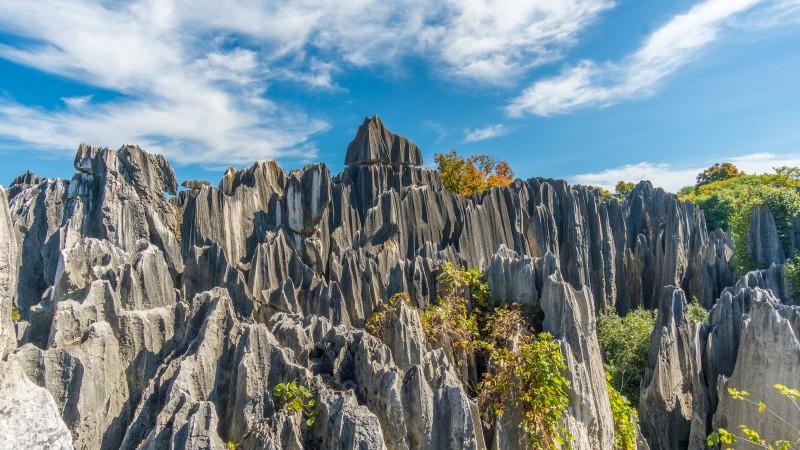
Stone Forest - © MIA
Must-Try Dishes in Kunming
Kunming’s culinary tradition offers a delightful array of dishes that highlight the unique flavors of Yunnan Province. Give these dishes a taste and you will experience a true taste of the local cuisine:
- Across the Bridge Rice Noodles (Guoqiao Mixian): This iconic dish features thinly sliced meats, fresh vegetables, and rice noodles, which are added to a hot, flavorful broth right at your table. The steaming broth cooks the ingredients, creating a deliciously aromatic and customizable meal.
- Yunnan Ham (Xuanwei Ham): Renowned for its rich and deep flavor, this cured ham is a staple in Yunnan cuisine. It’s commonly used in soups, stir-fries, and as a savory addition to various dishes, providing a distinctive taste that reflects the region’s culinary heritage.
- Steam Pot Chicken (Qiguo Ji): A traditional dish cooked in a unique clay pot, which infuses the chicken with the flavors of medicinal herbs and spices. This method of cooking results in tender, flavorful chicken and a broth that’s both nourishing and delicious.
- Erkuai: A type of rice cake that’s either grilled or stir-fried, Erkuai is typically served with a spicy, flavorful sauce. This dish is a popular street food item, offering a chewy texture and robust taste that’s both filling and delicious.
- Cross-Bridge Tofu (Guoqiao Doufu): A vegetarian twist on the classic Across the Bridge Rice Noodles, this dish features tofu instead of meat. Served with a variety of fresh vegetables and a savory broth, it’s a hearty and satisfying option for those who prefer plant-based meals.
- Mushroom Hotpot: A beloved communal dish, the mushroom hotpot includes a variety of mushrooms and vegetables simmered in a rich, savory broth. It’s ideal for sharing and offers a warm, comforting meal that highlights the region’s mushroom varieties.
- Yunnan Rice Noodles with Pickled Vegetables (Pao Mi Xian): These rice noodles are served with tangy pickled vegetables and a flavorful broth. The combination of textures and flavors makes this dish a delicious and satisfying option for any meal.
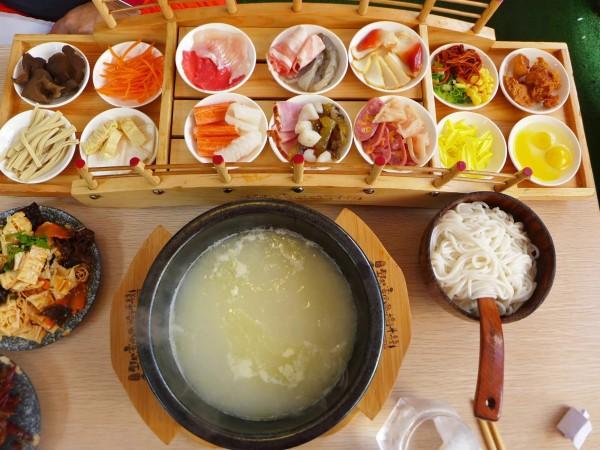
Across the Bridge Rice Noodles (Guoqiao Mixian) - © VnExpress
Festivals & Local Celebrations
Kunming’s calendar is filled with vibrant festivals and local celebrations that reflect the city’s rich cultural diversity. These gatherings provide a special window into the cultures and customs of Kunming's numerous ethnic groups.
- Torch Festival: Celebrated by the Yi people, the Torch Festival is one of Kunming’s most exciting events. Held in the summer, the festival features massive bonfires, traditional Yi dances, and wrestling competitions. The streets come alive with energy as locals and visitors join in the festivities, which are meant to ward off evil spirits and bring good luck.
- Kunming International Flower Expo: Kunming, often called the "City of Eternal Spring," celebrates its love of flowers every year at the International Flower Expo. This event showcases a stunning array of floral displays, highlighting the city’s reputation for horticultural excellence. It’s a must-visit for flower enthusiasts and a beautiful way to experience Kunming’s natural beauty.
- Water-Splashing Festival: This lively festival is celebrated by the Dai ethnic group and marks their New Year. Held in April, the Water-Splashing Festival is exactly what it sounds like—people drench each other in water to wash away bad luck and bring in good fortune. It’s a fun and refreshing way to experience Dai culture and join in the community spirit.
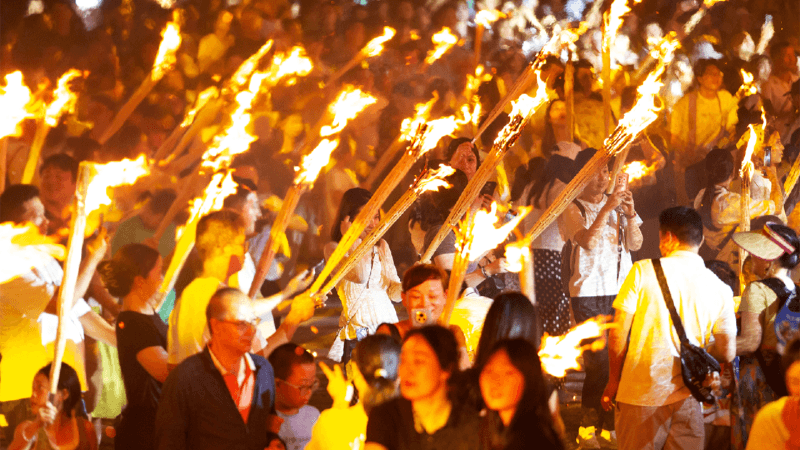
Torch Festival of the Yi people - © CGTN
What to Do in Kunming
- Hike the Western Hills (Xishan): Enjoy panoramic views of Dianchi Lake and explore scenic trails with ancient temples and carvings.
- Visit the Stone Forest (Shilin National Park): Wander through unique limestone formations that create a surreal landscape.
- Explore Yuantong Temple: Discover one of Kunming’s oldest Buddhist temples, known for its serene atmosphere and historical significance.
- Explore Guandu Old Town: Experience traditional architecture and local crafts in this well-preserved historic area.
- Shop on Nanping Street: Browse modern stores and boutiques in Kunming’s main shopping district.
- Browse the Bird and Flower Market: Find unique souvenirs, traditional Chinese medicines, and handcrafted items in this vibrant market.
Shopping in Kunming
- Nanping Street: Explore modern department stores and boutiques in Kunming’s bustling shopping district.
- Bird and Flower Market: Find unique souvenirs, traditional Chinese medicines, and handcrafted goods in this lively market.
- Jinma Biji Square: Discover antiques, calligraphy, and traditional Chinese crafts in this historic area.
- Kunming International Trade Center: A large shopping complex with a variety of stores selling electronics, fashion, and local products. It’s a great spot for finding high-quality items and unique souvenirs.
- Dongfeng East Road Shopping Area: Known for its diverse range of shops, including luxury brands, local boutiques, and specialty stores. This area is ideal for both high-end and everyday shopping.
- Kundu Flower Market: A vibrant market where you can buy fresh flowers, plants, and floral-themed souvenirs. It’s also a good place to experience the local culture and enjoy the colorful displays.
- Yunnan Provincial Museum Gift Shop: Located within the Yunnan Provincial Museum, this shop offers museum-themed souvenirs, traditional crafts, and local art. It’s a great place to find educational and culturally significant items.
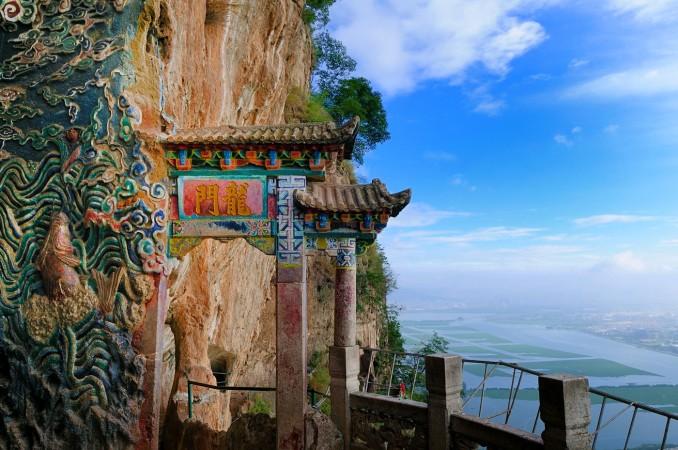
Hiking the Western Hills (Xishan Mountain) - © China Tourism
Weather in Kunming: Best Time to Visit
Kunming, often called the "City of Eternal Spring," offers a mild climate throughout the year, making it a great destination at any time. Here's a breakdown of the weather by season and the corresponding tourism trends:
Spring in Kunming
Spring is one of the best times to visit Kunming, with temperatures ranging from 15°C to 25°C (59°F to 77°F). The pleasant weather and blooming flowers attract many tourists to the city's parks and gardens, such as the Kunming Botanical Garden and the Western Hills. This season is perfect for outdoor activities and exploring Kunming’s natural beauty.
Summer in Kunming
Summer temperatures in Kunming range from 20°C to 30°C (68°F to 86°F). Although it is the rainy season, with occasional showers, the weather remains comfortable compared to other regions. The colder highlands of Kunming are ideal for summer visits, when you may take in the verdant scenery. The rainy season also brings vibrant greenery, enhancing the beauty of natural attractions like the Stone Forest.
Autumn in Kunming
Autumn mirrors spring with pleasant temperatures between 15°C and 25°C (59°F to 77°F) and dry weather. This is a popular time for sightseeing and outdoor activities. The clear skies and comfortable temperatures make it ideal for hiking the Western Hills or visiting cultural sites like Yuantong Temple.
Winter in Kunming
Winter temperatures range from 8°C to 20°C (46°F to 68°F). The weather is generally dry, but it can get cooler in the evenings. Winter is a quieter time for tourism, offering a more relaxed experience with fewer crowds at major attractions. It’s also a good period for enjoying indoor activities and cultural experiences.
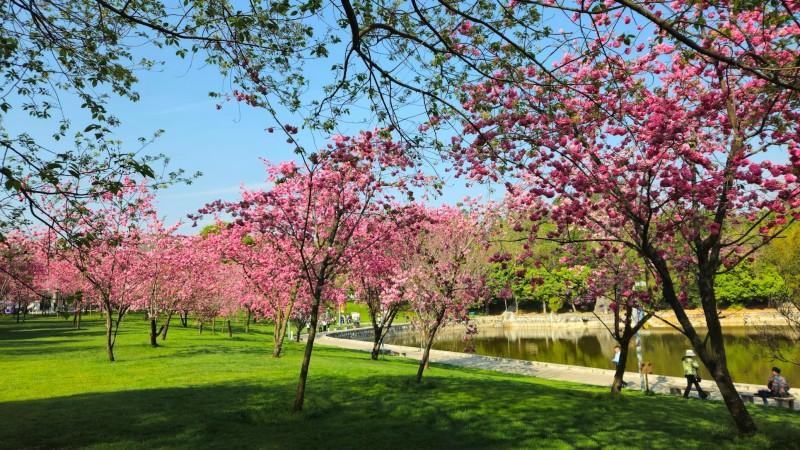
Spring in Kunming - © Chuck Eugene
Culture Etiquette in Kunming
When visiting Kunming, being aware of local customs and etiquette can enhance your experience and show respect for the culture. Here are some unique local practices to keep in mind:
- Warm Greetings: It's customary to shake hands amicably when you meet someone. In more traditional settings, a slight bow or nod of the head can be a polite gesture. Addressing people with proper titles and showing respect for elders is highly valued.
- Dining Etiquette: During meals, it’s customary to wait for the host to begin eating before you start. Sharing dishes is typical, so be prepared to use communal chopsticks provided for serving food. It’s polite to try a bit of each dish offered.
- Respect for Local Traditions: Wear modest clothing and take off your sunglasses and hat when you visit temples or other places of worship. It’s important to follow any posted guidelines and show respect by not touching sacred objects or interrupting ceremonies.
- Gift-Giving: Small gifts or tokens of appreciation are appreciated when visiting someone’s home. Traditional gifts include fruits, sweets, or local specialties. Avoid giving clocks or umbrellas, as they are associated with funerals and bad luck.
- Public Behavior: Public displays of affection are generally reserved and may be seen as inappropriate in more traditional settings. Speaking softly and avoiding loud conversations will help you blend in with the local culture.
- Respect for Nature: Kunming is known for its beautiful natural landscapes, so be mindful of your environmental impact. Follow designated paths and dispose of trash properly to help preserve the city’s natural beauty.
Essential Travel Information
Getting Around Kunming
Navigating Kunming is easy with a range of transportation options. The city has a well-developed, reasonably priced bus system that travels to most locations, including popular districts and sites. For a quicker and more efficient way to travel, the modern subway system connects key areas and helps avoid traffic. Taxis are widely available and reasonably priced, and ride-sharing services provide a convenient alternative. For shorter trips, renting a bicycle or e-scooter offers a fun and eco-friendly way to explore the city. If you're planning to venture beyond Kunming, car rentals offer flexibility, but make sure to familiarize yourself with local driving regulations and road conditions.
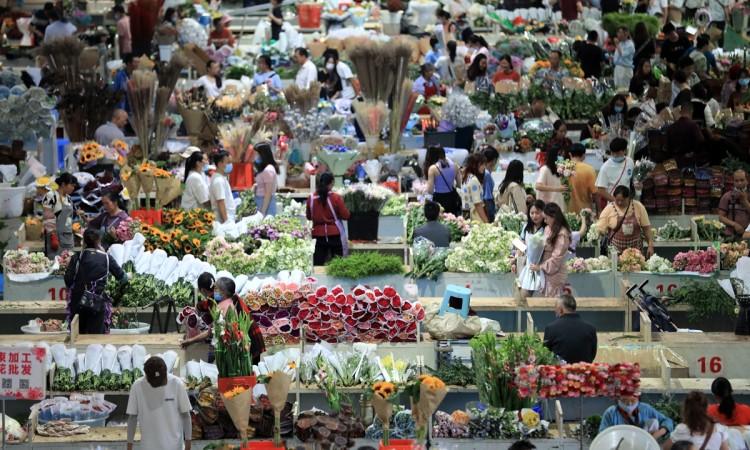
Wander around Bird and Flower Market - © Global Times
ATM & Banking Services
Managing your finances in Kunming is straightforward, with numerous banking services readily available. ATMs are widespread throughout the city, including in major shopping areas and transport hubs, and most accept international cards, though it’s wise to check for any transaction fees with your bank beforehand. Banks offer a variety of services such as currency exchange and cash withdrawals. Additionally, currency exchange services can be found at both banks and dedicated counters, so it’s a good idea to exchange a small amount before arriving to cover immediate expenses.
Where to Stay in Kunming
Kunming has a selection of lodging choices to suit different tastes and price ranges. For a luxurious experience, you can choose high-end hotels that provide top-notch amenities, including spas, fine dining, and central locations. Mid-range hotels offer comfort and affordability, with quality services and convenient access to major attractions. Budget-conscious travelers will find clean and basic accommodations in budget hotels and hostels. For a more personalized stay, consider homestays and guesthouses, which offer a chance to experience local hospitality and gain insights into daily life in Kunming.
Des articles pour vous

Voyage à Kampong Cham - Cambodge, Asie
Kampong Cham est une charmante ville riveraine située le long du fleuve Mékong. Connue pour son importance historique et ses attractions culturelles, Kampong Cham offre un mélange d'architecture coloniale, de temples anciens et de paysages pittoresques. Kampong Cham est reliée au district voisin de Tbong Khmum par le pont Kizuna, le premier pont au Cambodge à traverser le fleuve Mékong, en faisant un carrefour de transport crucial pour la région.
Population : Estimation de 80 000 habitants (en 2024)
Économie : Bien que n'étant pas encore une destination touristique majeure, Kampong Cham propose des sites culturels et historiques, tels que le temple Wat Nokor et le pont en bambou de Koh Pen, ainsi que des attractions naturelles comme des forêts et des chutes d'eau. Le gouvernement se concentre sur le développement du tourisme pour améliorer l'économie locale.
Points d'intérêt : Wat Nokor Bachey, Phnom Han Chey, Phnom Pros et Phnom Srey, pont en bambou de Koh Pen, Wat Joy T'maw, Preah Theat Teuk Chha, piste d'atterrissage abandonnée de l'US.

Explorez Nha Trang - Voyage au centre du Vietnam, Asie
Nichée le long de la magnifique côte du Vietnam, Nha Trang se distingue comme une destination de premier choix pour les voyageurs. Cette ville côtière, réputée pour ses superbes plages et sa vie marine foisonnante, s'adresse à tous. Nha Trang vous accueille à bras ouverts, que vous recherchiez des aventures, de la culture ou de la détente au bord de la mer. Ce guide vous fera découvrir les points forts de cet endroit magnifique, facilitant ainsi la planification de votre voyage de manière fluide et excitante.
Population : Environ 423 000 habitants en 2019.
Économie : L'un des principaux centres touristiques du Vietnam et la plus grande économie de la province de Khanh Hoa.
Sites emblématiques : Célèbre pour les tours Cham de Po Nagar, la cathédrale de Nha Trang et l'île Hon Mun.

Voyage à Sihanoukville - Cambodge, Asie
Sihanoukville, une ville côtière du sud-ouest du Cambodge, est la capitale de la province de Preah Sihanouk. Située sur une péninsule le long du golfe de Thaïlande, la ville est bien reliée à Phnom Penh par des autoroutes principales et dispose d'un aéroport international.
La ville abrite le seul port en eau profonde du Cambodge, jouant un rôle crucial dans la logistique et le commerce du pays. Les plages magnifiques de Sihanoukville, telles qu'Ochheuteal et Serendipity, attirent aussi bien les touristes nationaux qu'internationaux. Le développement économique a prospéré ces dernières années, en particulier grâce à la création de la Zone économique spéciale de Sihanoukville (SSEZ) et aux investissements chinois dans les casinos, l'immobilier et les stations balnéaires. La ville offre également des attractions naturelles telles que le parc national de Ream et plusieurs îles voisines, en faisant une destination variée pour les voyageurs d'affaires et de loisirs.
Population : La population de Sihanoukville était d'environ 160 000 habitants en 2024.
Économie : Sihanoukville, une ville côtière en pleine croissance au Cambodge, se distingue par son mélange dynamique de développement économique et de tourisme. La Zone économique spéciale de Sihanoukville (SSEZ) est devenue un pôle industriel majeur, abritant plus de 180 entreprises et créant des milliers d'emplois. Avec le seul port en eau profonde du Cambodge, la ville joue un rôle clé dans le commerce et la logistique du pays. Bien qu'elle se soit transformée d'une petite ville balnéaire tranquille en un centre urbain animé, Sihanoukville reste célèbre pour ses plages immaculées, attirant des touristes tout au long de l'année. Les investissements chinois importants ont alimenté la croissance des hôtels, des casinos et de l'immobilier, faisant de la ville un centre d'opportunités économiques et d'hospitalité.
Monuments : Plage d'Otres, Plage d'Ochheuteal, Plage de l'Indépendance, Parc national de Ream, Chute d'eau de Kbal Chhay, Monument des Lions d'Or, Wat Leu.

Explorez Kharkhorin - Voyage en Mongolie, Asie
Bienvenue à Kharkhorin, un trésor historique niché au cœur de la Mongolie. Ancienne capitale vibrante de l'Empire Mongol sous le légendaire Gengis Khan, Kharkhorin se dresse comme un témoignage de la riche culture et de l'histoire de la Mongolie. Cette ville antique possède une combinaison unique d'importance historique et de paysages époustouflants, en faisant une destination incontournable pour un voyage de rêve en Mongolie. En mettant le pied à Kharkhorin, vous ferez un saut dans le temps, à une époque de grands palais, de routes commerciales prospères et d'échanges culturels sans pareils. Que vous soyez intrigué par les ruines anciennes, désireux d'explorer les traditions locales ou simplement en quête d'une immersion dans la beauté naturelle de la Mongolie, Kharkhorin a quelque chose à offrir à chacun.
Population : Environ 1 000 habitants en 2020.
Économie : L'une des attractions touristiques les plus importantes de la Mongolie et l'ancienne capitale de l'Empire Mongol.
Monuments : Célèbre pour les Ruines de Kharkhorin, le Monastère d'Erdene Zuu, et la Vallée d'Orkhon, un site du patrimoine mondial de l'UNESCO.

Explore Luang Prabang - Laos Travel, Asia
Luang Prabang, nestled in northern Laos at the meeting point of the Mekong river and Nam Khan river, is a city celebrated for its rich cultural heritage and stunning natural beauty. Recognized as a UNESCO World Heritage Site in 1995, it boasts a unique blend of traditional Lao and French architecture that has been carefully preserved. Whether you're wandering through its ancient temples, admiring the local architecture, or soaking in the natural beauty of waterfalls and rivers, Luang Prabang offers something for everyone.
Population: Approximately 470,000 in 2020.
Economy: Luang Prabang's economy thrives on tourism, with its UNESCO status drawing visitors to its temples, natural wonders, and cultural experiences. Local crafts, hospitality, and small businesses also play vital roles, supporting the town's sustainable growth. Local crafts, hospitality, and small businesses also play vital roles, supporting the town's sustainable growth.
Landmarks: Famous for the Wat Xieng Thong, Royal Palace Museum (also known as Haw Kham), and Mount Phousi (Phou Si Hill).Luang Prabang, nestled in northern Laos at the meeting point of the Mekong river and Nam Khan river, is a city celebrated for its rich cultural heritage and stunning natural beauty. Recognized as a UNESCO World Heritage Site in 1995, it boasts a unique blend of traditional Lao and French architecture that has been carefully preserved. Whether you're wandering through its ancient temples, admiring the local architecture, or soaking in the natural beauty of waterfalls and rivers, Luang Prabang offers something for everyone.
Population: Approximately 470,000 in 2020.
Economy: Luang Prabang's economy thrives on tourism, with its UNESCO status drawing visitors to its temples, natural wonders, and cultural experiences. Local crafts, hospitality, and small businesses also play vital roles, supporting the town's sustainable growth. Local crafts, hospitality, and small businesses also play vital roles, supporting the town's sustainable growth.
Landmarks: Famous for the Wat Xieng Thong, Royal Palace Museum (also known as Haw Kham), and Mount Phousi (Phou Si Hill).

Explore Vientiane - Laos Travel, Asia
Vientiane, the capital of Laos, offers a unique travel experience for those looking to explore a peaceful Southeast Asian city with a deep connection to its cultural roots. Unlike other bustling capitals, Vientiane boasts a serene and laid-back atmosphere, making it a perfect destination for travelers wanting to escape the chaos of more crowded cities. This charming city sits along the Mekong River, offering scenic views, rich history, and a vibrant yet tranquil way of life. As a gateway to exploring Laos, this capital invites you to slow down, immerse in its heritage, and enjoy the local flavors.
Population: Approximately 840,000 in 2023.
Economy: Vientiane's economy is growing steadily, driven by government services, trade, and tourism. Key sectors include agriculture, manufacturing, and construction. The city's strategic location along the Mekong River supports trade with neighboring Thailand and Vietnam.
Landmarks: Famous for the Pha That Luang, Patuxai, and the Buddha Park (or Wat Xieng Khuan).
